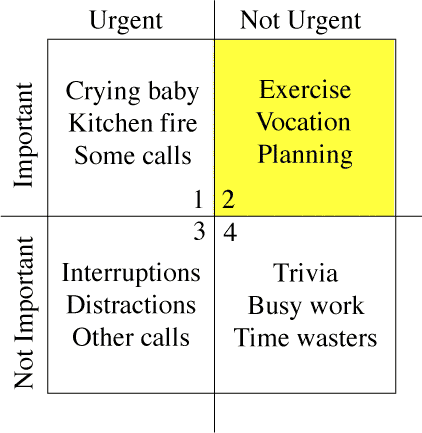Prioritization is the Hardest Thing
Ideas are a dime a dozen, especially in the software world. When building products the original idea is just a jumping off point or one solution to a problem. As a product comes together new ideas and new approaches flood the minds of everyone involved. The rapid pace of new ideas leads to a great deal of excitement, but all of the ideas can’t fit into the first release, there’s just not enough time. Time management is essential to new product development.
In The 7 Habits of Highly Effective People Stephen Covey states that time management is to organize and execute around priorities, nowhere is this more important than in the software world. Successfully building something from scratch requires the ability to prioritize all of the competing ideas and execute on the most beneficial. The prioritization matrix laid out by Covey is a great guide for development projects, but the meanings of each quadrant take on a slightly different meaning in development projects.
The Matrix
The matrix Covey describes is officially attributed to Eisenhower, it divides activities by importance and urgency creating four quadrants.

Quadrant I – Important, Urgent
This is traditionally the quadrant that most people spend their time in, running from place to place putting out fires. Too much work in this quadrant make it hard to make any headway.
The MVP is made up of a set of core features that are important and urgent. Remove any parts of the MVP and the product will cease to have value. As the project matures Quadrant I activities focus around bugs and feature requests from users. Well-run projects will replace Quadrant I with Quadrant II activities as time passes.
Quadrant II – Important, Not Urgent
Quadrant II is where the most effective work occurs. Activities in Quadrant II usually leads to long-term benefits.
Not much work is done in Quadrant II at the beginning of a project, all of the more urgent activities take precedence, but this can’t go on forever. Quadrant II activities add long-term value. Urgent activities can easily get in the way of Quadrant II activities, but Quadrant II activities provide the most value in the long-run. Polishing features, deeper testing, optimization, and refactoring all fall into Quadrant II. The activities may seem unnecessary now, but pay off down the road.
Quadrant III – Not Important, Urgent
It’s easy to misidentify activities in Quadrant III as being important and suck time away from the truly important activities. In many cases these may be important to someone, but not the project as a whole.
A single user requesting an obscure feature falls into Quadrant III (unless they’re your only user). In an MVP many
Quadrant IV – Not Important, Not Urgent
Quadrant IV is usually considered the escape quadrant, even though these activities are not important and not urgent they can be beneficial.
Adding character to a product is usually not important and certainly not urgent. If the core doesn’t work it doesn’t matter how much it is dressed up, but if the core is working well adding some personality can help lock in your users. Some kinds of polish or easter eggs fall into Quadrant IV.
Prioritization
When designing new features or writing user stories it’s important to determine which quadrant the feature falls into, if it’s not I or II consider pushing the feature to another release or dropping it all-together. Prioritization reclaims time, which is the most limited resource a product builder has.
